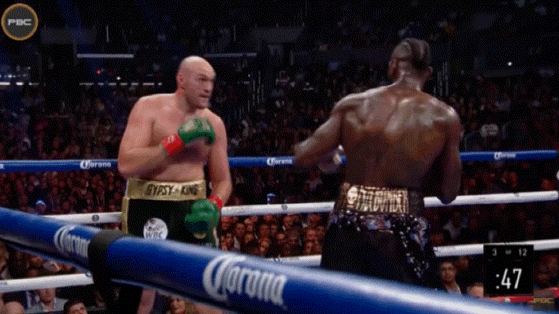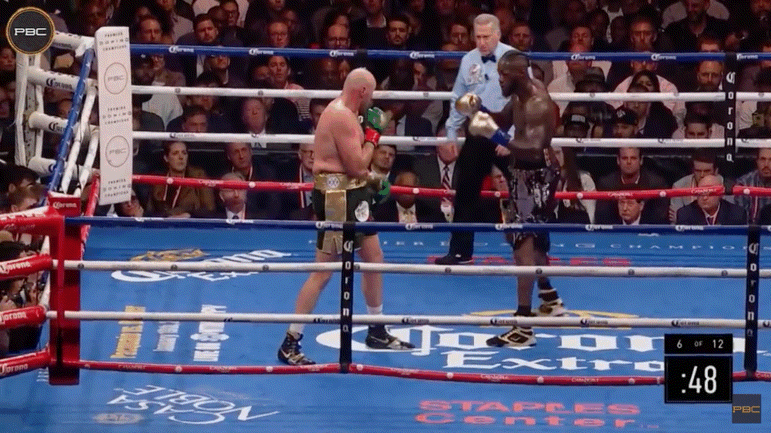Deontay Wilder vs. Tyson Fury I: Fight Breakdown
Photo by Harry How/Getty Images
“These fighters have to be perfect for 12 rounds, I only have to be perfect for 2 seconds.” - Deontay Wilder.
It’s finally here. On Saturday night, the epicentre of big-time boxing — Las Vegas, Nevada — will host the hotly-anticipated rematch between Deontay Wilder and Tyson Fury. It may be the marquee boxing event of 2020, and the most significant heavyweight fight in well over a decade, but a great deal of the intrigue surrounding the showdown can be attributed to the thrill and controversy of the pair’s first encounter. When Wilder and Fury first went toe-to-toe back in December 2018, they produced an unforgettable night of drama, and one that immediately demanded to be rerun.
To provide the perfect prologue to the sequel, here’s a closer look at Wilder vs. Fury I.
Round 1
Fury set out from the opening bell to disrupt Wilder’s rhythm by feinting consistently. Fury would jerk and twitch forward, emphasising head and shoulder movement, and stutter-step to offset Wilder.
Defensively, Wilder’s primarily a reactive fighter. Here, Fury’s level-change feint froze Wilder’s movement and broke the rhythm of Wilder’s pawing jab — a pivotal instrument in setting up a fight-ending right hand. Wilder would flinch and react to Fury’s feinting very easily, making establishing a consistent jab problematic.
Wilder did, however, successfully employ a body jab, targeting Fury’s more stationary midsection and pressing Tyson back.
Before Wilder made a key adjustment later in the fight, Fury read Wilder’s right hand like a children’s book. Whenever Wilder stepped in with a jab, Fury would anticipate a subsequent right hand and duck underneath it. At the end of Round 1, Fury sent Wilder off balance after ducking under a right, and, in an otherwise quiet opening round, momentarily staggered Wilder with a right hand around the ear.
Round 2
Here, Wilder threw a singular jab without following up with a right hand. Evidently, Fury would still duck in response to Wilder’s jab, even when a right hand didn’t subsequently follow. Fury wasn’t, however, ducking underneath Wilder’s jab (not intentionally, anyway), but rather slipping outside of it and immediately ducking. Unlike Wilder’s reactive defense, Fury would proactively anticipate a right hand before it came, rather than duck under it after it had already been thrown. In short, Fury meant to defend a 1-2, only Wilder didn’t throw the ‘2’. Wilder then threw a double-jab. Fury, again anticipating a 1-2, ducked immediately after Wilder’s first jab. Expecting to duck under a right hand, Fury instead ducked under a follow-up jab.
Wilder’s a constant, fight-ending threat to any opponent, so moving into range isn’t exactly risk-free. Fury would feint into range before throwing to freeze Wilder’s offense. Here, Fury’s feint raised Wilder’s guard and created an opportunity to step inside of Wilder’s preferred punching range without taking return fire, allowing Fury to deliver a short-left hook-right hook combination around Wilder’s high guard.
Round 3
Brilliance from Fury in the third round, and a perfect summation of an impressively executed overall game-plan. Fury read Wilder’s right hand and ducked under it, before spinning away, freezing Wilder with a double-feint, and landing a clean 1-2 straight down the middle of Wilder’s raised guard. Wilder would hastily throw a counter left hook nearly every time Fury landed a straight right hand, so Fury knew to roll after landing the 1-2.
Fury’s back-handed, flicker jab served to occupy and manipulate Wilder’s guard, blinding Wilder and forcing a reaction. Wilder attempted to parry Fury’s jab, prompting Fury to come around the guard with a short-left hook, which he followed up with a right hand over Wilder’s static left arm. Fury’s mobility whilst jabbing only exacerbated Wilder’s inability to counter effectively.
Wilder made a relatively early, but sporadic and poorly executed adjustment to Fury’s ducking. He’d fake the 1-2, causing Fury to duck a potential right hand, then throw a left hook designed to meet Fury’s lowered head.
Round 4
Fury would constantly change direction in order to prevent Wilder from lining up a target, circling left and right. Here, Fury was able to control the rhythm of the action by forcing Wilder to adjust his positioning. Fury didn’t utilise this side-to-side movement as often as he did against Wladimir Klitschko, generally preferring to stand in front of Wilder and roll the right hand.
Here, Fury threw a double-feint to make Wilder hesitant to fire back (you’ll see Wilder’s glove flinch). Wilder’s unable to tell where and when the threat’s likely to come, increasing Fury’s chance of landing clean. Fury then flicked a backhanded double-jab into Wilder’s guard, intending to follow up with a right hand. However, Wilder anticipated Fury’s follow-up and attempted to land a counter left hook. Neither Fury’s right nor Wilder’s left landed clean, cancelling each other out.
Here, Fury’s high feint raised Wilder’s guard, setting him up for a body shot. Fury landed a right hook (body)-left hook (head) combination, before stepping back and adjusting into a southpaw stance. Fury fighting southpaw led Wilder to step outside of Fury’s lead foot and throw a telegraphed 1-2-1. Fury couldn’t easily duck under Wilder’s right hand fighting southpaw, so instead leaned back, slipped and parried the right hand, and shoulder-rolled the follow-up jab.
Round 5
Fury’s shot selection and manipulation of Wilder’s guard were outstanding. First, he’d flick out a backhanded double-jab to raise and occupy Wilder’s guard, noticing Wilder’s tendency to employ a basic earmuff defence when under fire. He’d then either hook around Wilder’s static guard or throw straight up the middle, all whilst circling to the left, staying off centre and safely exiting out of Wilder’s punching range.
Round 6
Wilder can be a bit of an ‘I go, you go’ type of fighter, who won’t typically exchange with an advancing opponent or engage in a firefight. Defensively, he’ll essentially just cover up and back away, employing little lateral, head or upper-body movement. Here, Wilder led with a jab and Fury ducked, expecting a right hand (an aforementioned defensive habit). Fury, keeping himself balanced and in range to counter, then caught Wilder off guard by springing into an attack out of a southpaw stance, again exploiting Wilder’s static earmuff defence with good shot selection.
Fury’s level-change, set up by ducking following Wilder’s jab, created an opportunity to jab Wilder’s body. After throwing one body jab, which lowered Wilder’s right glove, Fury then faked another, but instead caught Wilder off guard by throwing an Andre Ward-esque upward jab.
Here, Wilder’ raised guard indicated to Fury that he wouldn’t throw a punch, lulling Fury into a false sense of security. Furthermore, instead of freezing Wilder, Fury’s feint signalled for Wilder to throw a stiff jab, throwing off Fury’s rhythm.
Round 7
Pay attention to Wilder’s right glove here. Fury’s feint led Wilder to believe he’d follow up with a backhanded flicker jab, as he’d done throughout the fight, so Wilder lowered his right glove in an attempt to parry away Fury’s feinted jab. Therefore, the feint created the perfect opening to land a clean short-left hook. Again, Wilder came back with his own left hook, knowing Fury would follow up with a straight right hand. Wilder’s hook intercepted Fury’s right and sent the punch off target.
Fury’s excellent defense was on full display in the seventh round. He’d duck under Wilder’s punches by bending at the hips, ensuring he was always ready to slip or roll the next punch and never finding himself in a position he couldn’t weave out of.
Fury landing a quick-fire 1-2 through Wilder’s high guard. Fury’s flicker jab blocked Wilder’s vision and drew out Wilder’s snatching counter left hook, which created a cleaner opening for Fury’s straight right hand.
Round 8
Fury’s consistent double-jabbing played havoc with Wilder’s guard and set up the right cross.
Here, Fury evaded Wilder’s 1-2-3 combination (Wilder began following up the 1-2 with a left hook, looking to meet Fury’s ducked head), but wasn’t given any time to reset before Wilder immediately sprung into another combination. You’ll notice Fury wipe his nose here, signalling for Wilder to throw and catch him off guard (this may come into play more significantly later on).
Round 9
Earlier in the breakdown, I mentioned that Wilder made a key adjustment late in the fight. I’ve already mentioned Wilder following up the 1-2 with a left hook, but Wilder also began aiming the right hand lower to neutralise Fury ducking under it. Here, both the aforementioned adjustments led to the first knockdown of the fight.
Fury came on strong after touching the canvas, winning the remainder of the round. Fury, knowing Wilder would have expended a lot of energy trying to close the show, began targeting the body with more emphasis and leaning on Wilder in the clinch.
Round 10
Until Usyk’s recent arrival at heavyweight, Fury’s defense was comfortably the best in the division. Fury’s ability to slip and roll punches whilst staying in range to counter stood out at points in this fight. After rolling a right hand, he’d be ready to roll a follow-up hook. After slipping a jab, he’d be ready to slip another jab in the opposite direction, all whilst maintaining balance. It’s made all the more impressive by the fact that he’s a giant heavyweight. At the same time, Fury fell in love with rolling and slipping punches in range, rather than utilising effective lateral movement, and he’d later pay the price.
Fury’s double-feint before jabbing put Wilder on the defensive and made him tentative to throw, allowing Fury the opportunity to attack an out-of-position Wilder.
Fury snapping Wilder’s head back with a straight right hand, set up, yet again, by a feint and a backhanded flicker jab. Fury doesn’t follow through with the right hand, perhaps due to the threat of Wilder’s counter left hook.
Round 11
As I highlighted earlier, Wilder would sporadically throw a lead left hook to meet Fury’s lowered head. Fury ducked after Wilder stepped in with the lead hand, but Wilder’s lead hook caught Fury off guard and landed on the side of his head.
Round 12
The moment that elevated their rivalry. Fury landed a clean right cross on Wilder’s chin, but before resetting (notice the nose wipe that signalled for Wilder to throw), Wilder blasted Fury to the canvas with a right cross-left hook combination. Wilder’s right hand was aimed lower and caught Fury in the midst of ducking.
Here’s the slow motion replay. Miraculously, Fury rose from the canvas and finished out the fight.
Fury’s fighting on instinct at this point. For the first time in the fight, Fury didn’t duck the right hand, but intercepted it with a right of his own, landing flush on Wilder’s chin and following up with a left hook.
Fury pushed the pace in the final minute, throwing to the body, tying Wilder up in the clinch, and using his near 50lb weight advantage to drive Wilder back. Despite getting heavily knocked down, Fury finished the final round on top of the action.
Irrespective of the two knockdowns, most observers, including myself, felt Fury deserved the decision. The Brit controlled the action and out-boxed Wilder for the majority of the fight. Alas, the fight was called a split draw, and Wilder retained his WBC world title. The fight perfectly encapsulated both the ferocious power-punching of Wilder and the slick boxing ability of Fury, whilst also displaying Wilder’s underrated aptitude to make fight-altering adjustments and Fury’s superhuman strength of will.
The score will be settled on Saturday night.































